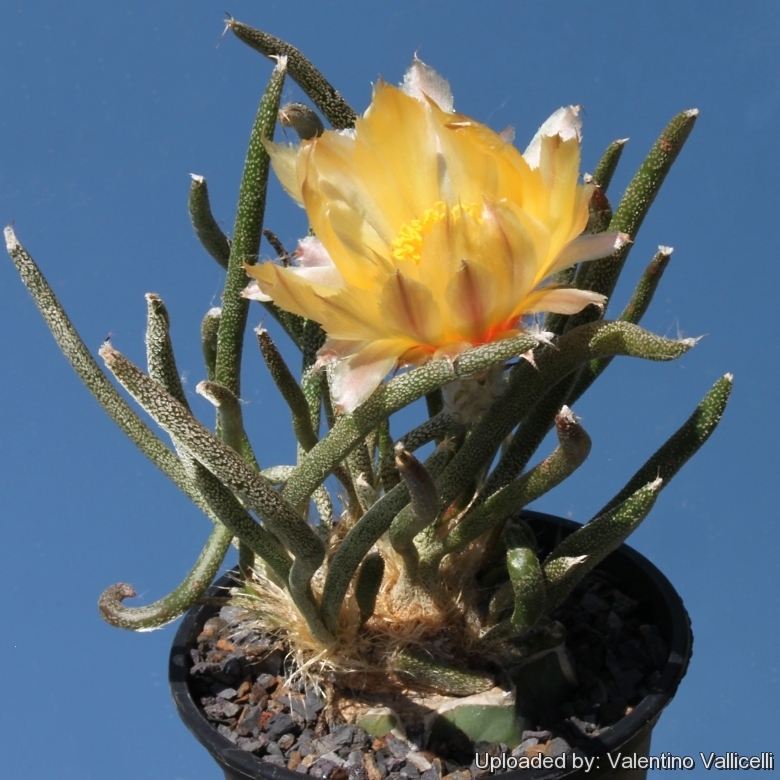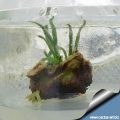
Astrophytum caput-medusae Photo by: Valentino Vallicelli
Origin and Habitat: Mexico, Nuevo León (locality withheld) and may be in El Herrero, Tamaulipas.
Altitude range: This species occurs at elevations of 100 to 200 metres above sea level.
Habitat: This species grows among shrubs in the Matorral espinoso tamaulipeco (Tamaulipan thornscrub land) in shaded position. It is known from only one site, and within its very limited range it is reportedly abundant. The species is considered Critically Endangered due to its very limited distribution (<100 km²), occurrence in a single location and rapid and ongoing decline due to illegal over collecting and trampling by livestock.
Synonyms:
See all synonyms of Astrophytum caput-medusae
back
Accepted name in llifle Database:Astrophytum caput-medusae (Velazco & Nevárez) D.R.HuntCactaceae Syst. Init. 15: 6 (2003).Synonymy: 4
back
Common Names include:
ABAZA (абаза бызшва): Medusita
Description: Solitary or rarely clustered up to 19 of eight.
Stem: Very reduced, shortly cylindrical, lacking ribs, with papyraceous bristles covering the collar and the stem apex, the bristles probably originate from the basal rest of the tubercles, the colour of the bristles of tubercles is coffee whit reddish tones, the stem bristle of plants growing in habitat rarely exceed the ground level.
Tubercles: Cylindrical or occasionally triangular when young, of cartilaginous consistency, smooth, could appear similar in aspect to leaves, up to 190 mm in length and of 2 to 5 mm wide, some times the adaxial portion of the base of the tubercle is cuneate. Epidermis verrucose, glaucous-green, covered by stigmas (squamiform peltate trichomes) of a greyish-white colour, covering almost the totality of the epidermis towards the base of the the tubercle.
Areoles: Dimorphic; the spiniferous one are terminals, circular or elliptical, with white wool; the floriferous one are located in the adaxial subterminal portion, separated from the spiniferous from 18 to 46 mm elliptical, with white wool, but noticeably larger than the spiniferous areoles.
Spines: 0 up to 4, generally persisting in old tubercles, of 1 to 3 mm in length, semi-erect, rigid, the base is whitish with a dark-coffee apex.
Roots: Primary root fusiform, fleshy; secondary roots fibrous. The root is of the same dimension or slightly smaller of the aerial part.
Flowers: Originates in the subterminal portion of the developing tubercles, not in the plant apex. The flowers are diurnal, yellow, with the base of the inner perianth segments orange coloured. Outer segments greenish yellow, The receptacular tube displays papyraceous, lanceolate scales, with terminal aristae and short white hairs in the axil; Lanceolate scales with white hairs in the axil are also presents in the pericarpel.
Fruit: Green and fleshy when young, covered with lanceolate scales with wool in the axil, dry when ripe with irregular longitudinal dehiscence.
Seeds: Big, up to 3 mm in length, cap-like, testa tuberculate , black or dark coffee coloured; hilum basal and very deep, micropyle, outside the hilum, but adjacent.
Subspecies, varieties, forms and cultivars of plants belonging to the Astrophytum caput-medusae group
 Astrophytum caput-medusae (Velazco & Nevárez) D.R.Hunt: has very thin tubercles, which are cartilaginous, smooth, similar to leaves, up to 190 mm in length and of 2 to 5 mm wide. Epidermis covered by stigmas. Distribution: Mexico, Nuevo León (locality withheld)
Astrophytum caput-medusae (Velazco & Nevárez) D.R.Hunt: has very thin tubercles, which are cartilaginous, smooth, similar to leaves, up to 190 mm in length and of 2 to 5 mm wide. Epidermis covered by stigmas. Distribution: Mexico, Nuevo León (locality withheld) Astrophytum caput-medusae f. nudum hort.: nude form, tubercles dark glossy-green. Garden origin.
Astrophytum caput-medusae f. nudum hort.: nude form, tubercles dark glossy-green. Garden origin.
Notes: Astrophytum subg. Stigmatodactylus D. Hunt nom. nov. 2003 (?)
Holotype: Herbarium of the science faculty - biology U.A.N.L. (UNL-023704)
Isotype: Herbarium of the science faculty - biology U.A.N.L. (UNL-023705), other material examined UNL-023706, UNL-023707, UNL-023708.:
Author: M. Nevárez de los Reyes M. and C. Velazco Macías.
Type locality: Mexico, Nuevo León.
Date: August 28 2001.
Basionym: Digitostigma caput-medusaeSN|3594]]SN|3594]] Velazco & Nevarez.
Original description in: VELAZCO, C.G.; NEVAREZ, M. Cact. Suc. Mex. 47(4):76-86, 2002
Bibliography: Major references and further lectures
1) Gómez-Hinostrosa, C. & Hernández, H.M. 2013. Astrophytum caput-medusae. The IUCN Red List of Threatened Species. Version 2015.2. <www.iucnredlist.org>. Downloaded on 23 June 2015.
2) Guzmán, U., S. Arias y P. Dávila. "Catálogo de Cactáceas Mexicanas." UNAM, CONABIO. México D.F. 2003.
3) Kiesling, R. "Nomenclatura de Digitostigma caput-medusae (Cactaceae)". Cactáceas y suculentas mexicanas. 52(1):20-24, 2007
4) Velazco Macías, C.G. y M. Nevarez de los Reyes. "Nuevo género de la familia
Cactaceae en el estado de Nuevo León, México: Digitostigma caput-medusae Velazco et Nevarez sp. nov." Cactáceas y suculentas mexicanas. 47(4): 76-86, 2002.
5) CONABIO 2010. "Medusita (Digitostigma caput-medusae)" Fichas de especies mexicanas. Comisión Nacional para el Conocimiento y Uso de la Biodiversidad y Comisión Nacional de Áreas Naturales Protegidas, México, D.F. Compilado por Carlos Gerardo Velazco Macías <http://www.biodiversidad.gob.mx/especies/especies_priori/fichas/pdf/medusita.pdf>
 A. Myriostigma and A. caput-medusae flowers. Photo kindly provided by Manuel Nevarez de los Reyes Photo by: Cactus Art
A. Myriostigma and A. caput-medusae flowers. Photo kindly provided by Manuel Nevarez de los Reyes Photo by: Cactus Art Astrophytum caput-medusae Photo by: Valentino Vallicelli
Astrophytum caput-medusae Photo by: Valentino Vallicelli Astrophytum caput-medusae Photo by: Valentino Vallicelli
Astrophytum caput-medusae Photo by: Valentino Vallicelli Astrophytum caput-medusae Photo by: Flavio Agrosi
Astrophytum caput-medusae Photo by: Flavio Agrosi Astrophytum caput-medusae Photo by: Valentino Vallicelli
Astrophytum caput-medusae Photo by: Valentino Vallicelli Astrophytum caput-medusae Photo by: Valentino Vallicelli
Astrophytum caput-medusae Photo by: Valentino Vallicelli Astrophytum caput-medusae Photo by: Valentino Vallicelli
Astrophytum caput-medusae Photo by: Valentino Vallicelli Astrophytum caput-medusae Photo by: Carolina González
Astrophytum caput-medusae Photo by: Carolina GonzálezCultivation and Propagation: - The plants grow very fast either grafted and on their own roots (possibly grafting is not required)
- Grafted plants are very sensible to drought, waterlessness for a few day conduct (especially in summer) to a complete or partial loss of tubercle that dry in a few hours, this seems due to the very small proportion of the stem, and to the fact that the big tap root (a water storage organ) is not present, in fact the plants on their own roots are more stable and resistant. Anyway the tubercles are deciduous, and easily dry and detach, but are soon replaced by new ones (a single tubercle can reach maturity in a few week)
- Young seedlings seem to need some light watering in winter, no damages or rot has been evidenced for plants watered in winter.
- They prefer a shaded or semi-shaded position as they live in habitat under shrubs.
- All the few plant under observation stopped to grow at the end of August, beginning a complete winter dormancy. The first sign of new growth appeared only on the month of march.
- The plant are quite resistant to frost (during winter the green house temperatures varied from a minimum of 0° C at night to a maximum of 25° C during sunny days) no sign of damage has been signalized.
Your Photos

by Cactus Art

by Valentino Vallicelli

by Viviana Alejandra Castro

by Cactus Art

by Valentino Vallicelli























